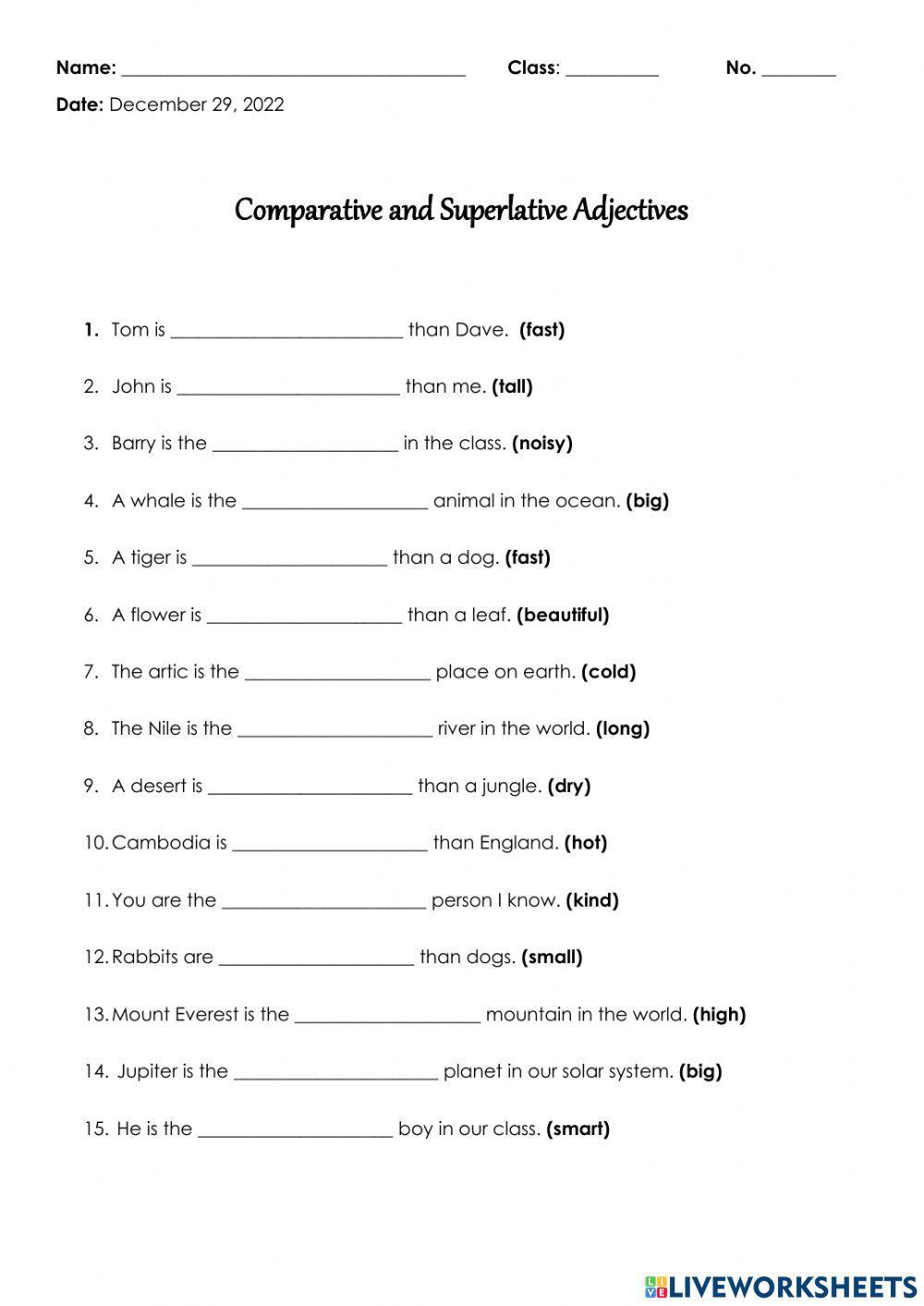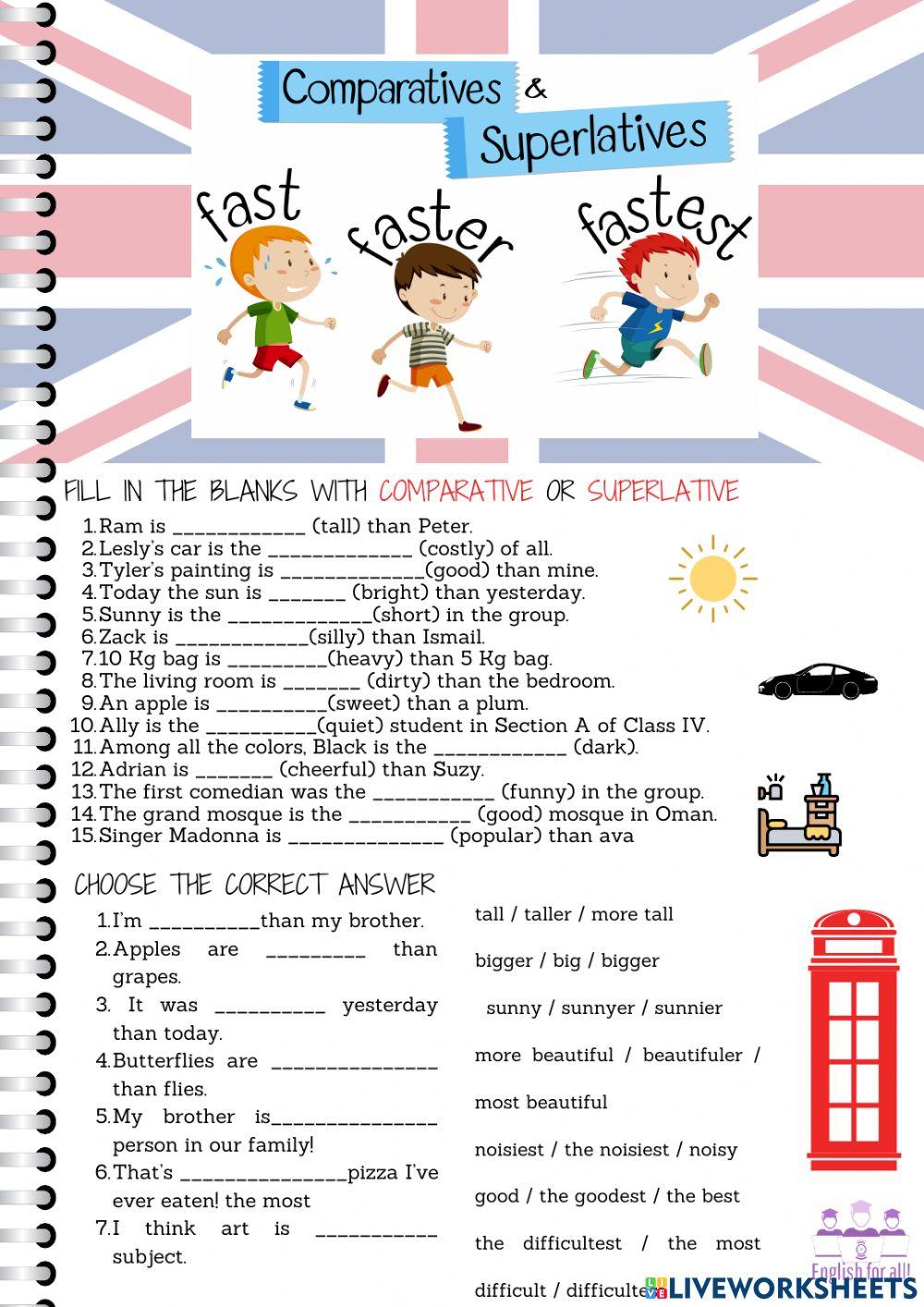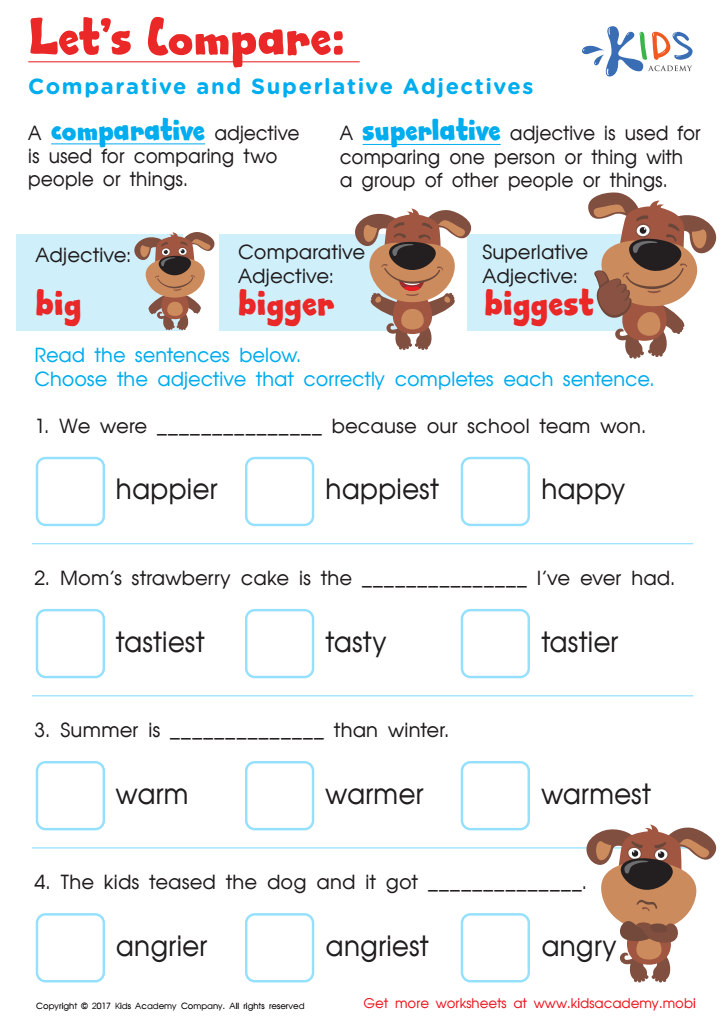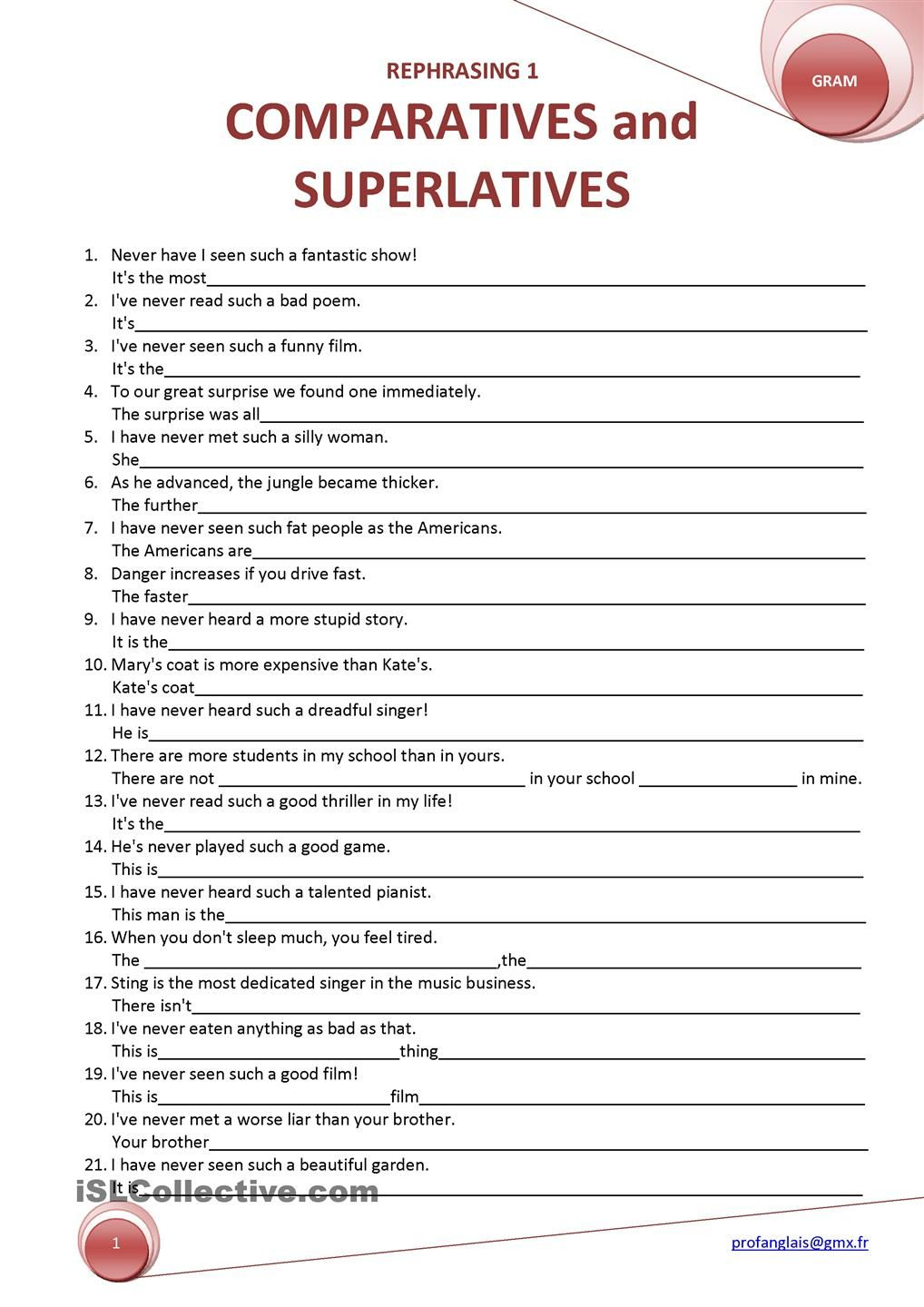
Mastering Degrees: A Comprehensive Guide to Comparative and Superlative for High School Worksheets
In the intricate tapestry of the English language, adjectives and adverbs play a pivotal role in adding color, detail, and precision to our communication. They allow us to describe, qualify, and, most importantly, compare. For high school students navigating the complexities of advanced grammar, mastering the correct usage of comparative and superlative forms is not just an academic exercise; it’s a fundamental skill for effective written and oral expression. This comprehensive guide will delve into the intricacies of comparatives and superlatives, highlighting how targeted comparative and superlative for high school worksheets serve as indispensable tools for achieving fluency and accuracy.
The Foundation: Understanding Comparatives

At its core, a comparative adjective or adverb is used when comparing two things. It helps us express which of the two has more or less of a particular quality. Think of it as drawing a direct line between two distinct entities and highlighting a difference.

Formation Rules for Comparatives:

-

Short Adjectives/Adverbs (one syllable):
- Add "-er" to the end of the word.
- Examples:
- Tall → Taller (My brother is taller than me.)
- Fast → Faster (A cheetah runs faster than a lion.)
- Old → Older (This tree is older than the house.)


- Spelling Note: If the word ends in a single vowel and a consonant, double the consonant before adding "-er" (e.g., big → bigger, hot → hotter).


-
Two-Syllable Adjectives/Adverbs Ending in "-y":
- Change the "y" to "i" and add "-er."
- Examples:
- Happy → Happier (She looks happier today.)
- Easy → Easier (This problem is easier than the last one.)
- Busy → Busier (He’s busier than usual this week.)
-
Longer Adjectives/Adverbs (two or more syllables not ending in "-y"):
- Use "more" before the adjective/adverb.
- Examples:
- Beautiful → More beautiful (The sunset was more beautiful than I expected.)
- Difficult → More difficult (Learning a new language can be more difficult than it seems.)
- Carefully → More carefully (Please drive more carefully on this road.)
-
Irregular Comparatives:
- Some common adjectives and adverbs have irregular comparative forms that do not follow the standard rules. These must be memorized.
- Examples:
- Good / Well → Better (Her grades are better this semester. He sings better now.)
- Bad / Badly → Worse (The weather got worse. He performed worse than last time.)
- Far → Farther / Further (Her house is farther down the road. We need further information.)
- Little (amount) → Less (I have less time today.)
- Much / Many → More (I need more sleep.)

Common Pitfalls with Comparatives:
- Double Comparatives: Avoid using both "more" and "-er" together (e.g., "more better" is incorrect; it should be "better").
- Missing "than": When comparing two things, the word "than" is usually required (e.g., "He is taller than his brother").
Elevating Comparisons: Understanding Superlatives
Superlative adjectives and adverbs are used when comparing three or more things (or one thing against a group) to indicate which one possesses the most or least of a particular quality. It identifies the extreme end of a spectrum.
Formation Rules for Superlatives:
-
Short Adjectives/Adverbs (one syllable):
- Add "-est" to the end of the word.
- Examples:
- Tall → Tallest (He is the tallest student in the class.)
- Fast → Fastest (The cheetah is the fastest land animal.)
- Old → Oldest (This is the oldest building in the city.)
- Spelling Note: Similar to comparatives, double the consonant if the word ends in a single vowel and a consonant (e.g., big → biggest, hot → hottest).
-
Two-Syllable Adjectives/Adverbs Ending in "-y":
- Change the "y" to "i" and add "-est."
- Examples:
- Happy → Happiest (She is the happiest person I know.)
- Easy → Easiest (This was the easiest test all year.)
- Busy → Busiest (Friday is usually the busiest day of the week.)
-
Longer Adjectives/Adverbs (two or more syllables not ending in "-y"):
- Use "most" before the adjective/adverb.
- Examples:
- Beautiful → Most beautiful (That was the most beautiful painting in the exhibition.)
- Difficult → Most difficult (This is the most difficult concept to grasp.)
- Carefully → Most carefully (He handled the antique most carefully.)
-
Irregular Superlatives:
- These forms also need to be memorized.
- Examples:
- Good / Well → Best (She is the best student. He sings best when he’s relaxed.)
- Bad / Badly → Worst (That was the worst movie ever. He performed worst in the last round.)
- Far → Farthest / Furthest (Pluto is the farthest planet from the sun. We need the furthest possible reach.)
- Little (amount) → Least (That’s the least of my worries.)
- Much / Many → Most (Who ate the most cake?)
Common Pitfalls with Superlatives:
- Missing "the": Superlatives almost always require the definite article "the" before them (e.g., "He is the tallest").
- Double Superlatives: Avoid using both "most" and "-est" together (e.g., "most fastest" is incorrect; it should be "fastest").
- Absolute Adjectives: Some adjectives describe absolute states and cannot be compared or made superlative (e.g., unique, perfect, empty, complete, dead). Something cannot be "more unique" or "most perfect" because uniqueness and perfection are absolute states.
Beyond the Basics: Nuances and Advanced Usage
High school grammar goes beyond rote memorization. Understanding the subtleties of comparatives and superlatives is crucial.
- Using "Less" and "Least": Just as "more" and "most" indicate a greater degree, "less" and "least" indicate a lesser degree.
- Examples: This book is less interesting than the last one. That was the least enjoyable part of the trip.
- Adjectives vs. Adverbs: Remember that adjectives modify nouns/pronouns, and adverbs modify verbs, adjectives, or other adverbs. While many adverbs form comparatives and superlatives with "more/most" (e.g., "quickly" → "more quickly"), some share forms with adjectives (e.g., "fast," "hard," "early").
- She runs fast (adverb). She is a fast runner (adjective). She runs faster than him. She runs the fastest in the team.
- Implied Comparisons: Sometimes, the comparison is implied rather than explicitly stated.
- Example: "Of the two options, this one is better." (The comparison is between "this one" and "the other option," which is understood.)
The Indispensable Role of Comparative and Superlative for High School Worksheets
The theoretical understanding of comparatives and superlatives is only the first step. To truly internalize these rules and apply them correctly in diverse contexts, consistent practice is paramount. This is precisely where well-designed comparative and superlative for high school worksheets come into play.
Why Worksheets are Essential Learning Tools:
- Reinforcement of Rules: Worksheets provide repetitive practice, cementing the formation rules (adding -er/-est, using more/most, handling irregulars) into students’ minds.
- Application in Varied Contexts: Good worksheets present exercises that go beyond simple fill-in-the-blanks. They might include sentence completion, error correction, rephrasing sentences, or even short creative writing prompts, forcing students to apply the rules in different scenarios.
- Identification of Common Errors: Worksheets often include examples of common mistakes (like double comparatives/superlatives or missing "the"), helping students recognize and avoid these pitfalls.
- Practice with Irregular Forms: Because irregular comparatives and superlatives must be memorized, dedicated sections in worksheets ensure students get ample practice with these tricky words.
- Building Confidence: Successfully completing exercises builds a student’s confidence in their grammatical abilities, encouraging them to use these forms more freely and accurately in their own writing and speech.
- Preparation for Standardized Tests: Standardized tests (like the SAT, ACT, TOEFL, IELTS) frequently assess grammar, including comparative and superlative usage. Worksheets familiarise students with question formats they might encounter.
- Differentiated Learning: Worksheets can be structured to cater to different learning levels, starting with basic identification and moving to more complex sentence construction or error analysis.
Beyond basic understanding, comparative and superlative for high school worksheets foster deeper analytical skills. They train students to identify the number of items being compared, the type of word (adjective or adverb), and the specific rule that applies, leading to a more nuanced grasp of English grammar.
Designing Effective Comparative and Superlative for High School Worksheets
For educators and students alike, knowing what makes an effective worksheet is key.
- Variety of Exercise Types:
- Fill-in-the-blank: Provide a sentence with a blank and the base adjective/adverb, requiring the student to supply the correct comparative or superlative form.
- Sentence Transformation: Give a simple sentence and ask students to rewrite it using a comparative or superlative.
- Error Correction: Present sentences with common comparative/superlative errors for students to identify and correct.
- Choose the Best Option: Multiple-choice questions that test understanding of context and formation.
- Short Paragraph Writing: Prompts that require students to use several comparative and superlative forms in a meaningful context (e.g., "Describe the best day of your life," "Compare two historical figures").
- Clear Instructions: Ensure students understand exactly what is expected of them for each exercise.
- Answer Keys: Self-correction is a powerful learning tool. Worksheets should ideally come with answer keys to allow students to check their work and understand where they went wrong.
- Real-World Scenarios: Use examples that are relevant and engaging for high school students, drawing from topics like sports, technology, current events, or personal experiences.
- Gradual Difficulty: Start with simpler exercises and gradually introduce more complex challenges, including irregular forms and nuanced usage.
Strategies for Students Using Worksheets
To maximize the benefits of comparative and superlative for high school worksheets, students should adopt an active and reflective approach:
- Review the Rules First: Before diving into exercises, quickly review the formation rules and the list of irregular forms.
- Attempt All Questions: Even if unsure, try to complete every question. This process helps identify areas of weakness.
- Check Your Work Carefully: Use the answer key not just to see if you’re right, but to understand why the correct answer is correct. Analyze your mistakes.
- Don’t Be Afraid to Ask: If a concept or a particular question remains confusing, seek clarification from a teacher or a peer.
- Practice Consistently: Grammar mastery is built through consistent effort, not last-minute cramming. Regularly engaging with comparative and superlative for high school worksheets will yield the best results.
Conclusion
The ability to compare and contrast effectively is a cornerstone of sophisticated communication. Comparatives and superlatives are not mere grammatical formalities; they are essential tools that enable us to articulate precise distinctions, express preferences, and paint vivid pictures with words. For high school students, understanding and correctly applying these forms is a significant step towards achieving fluency and academic success in English.
Ultimately, the consistent and thoughtful use of comparative and superlative for high school worksheets is not merely about memorizing rules; it’s about developing an intuitive understanding of how to describe and compare, preparing students not just for tests, but for a lifetime of clear, compelling, and accurate communication. By embracing these valuable resources, students can transform what might seem like daunting grammar into an accessible and ultimately empowering skill.
